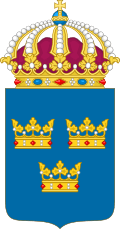Riksdag of the Estates
Riksdag of the Estates (formally Swedish: Riksens ständer; informally Swedish: Ståndsriksdagen) was the name used for the Estates of Sweden when they were assembled. Until its dissolution in 1866, the institution was the highest authority in Sweden next to the King. It was a Diet made up of the Four Estates, which historically were the lines of division in Swedish society:
Kingdom of Sweden
|
|---|
 |
| This article is part of a series on the politics and government of Sweden |
|
|
|
Related topics |
Important assemblies

The meeting at Arboga in 1435 is usually considered to be the first Riksdag, but there is no indication that the fourth estate, the peasants, had been represented there.
- The actual first meeting is likely the one that took place at Uppsala in 1436 after the death of rebel leader Engelbrekt.
- At the Riksdag in 1517, regent Sten Sture the Younger and the Privy Council deposed archbishop Gustav Trolle.
- At Västerås in 1527 Lutheranism was adopted as the new state religion instead of Roman Catholicism.
- At Arboga in 1561, the term Riksdag was used for the first time.[1]
- At Söderköping in 1595, duke Charles was elected regent of Sweden instead of king Sigismund, who was a Catholic and the king of both Sweden and Poland.
- In 1612 the Riksdag gave the nobility the privilege and right to hold all higher offices of government, after successful lobbying by Axel Oxenstierna.
- The first open conflict between the different estates happened in 1650.
- At the Riksdag in 1680 a large scale reduction (a return of lands to the Crown earlier granted to the nobility) was enacted, and Sweden became an absolute monarchy.
- In 1719, the Riksdag elected Ulrika Eleonora as heir in place of her older sister's son, and Ulrika Eleonora accepted a new constitution restoring the powers of the Riksdag.
- In 1771-1772, when Gustavus III after his Revolution of 1772 introduced a new Instrument of Government.
- In 1789, the Riksdag accepted an addition to the instrument of government from 1772. This new law, the Union and Security Act, abolished most noble privileges and commoners, regardless of rank, could hold virtually any office Sweden.
- In 1809, the Riksdag elected Charles XIII king after his nephew Gustav IV Adolf had been deposed, and after the new king had accepted a new constitution that ended Sweden's second Autocracy (1789–1809).
- At the sessions in 1634, 1719, 1720, 1772 and 1809 new constitutions were adopted.
Replaced by the new Riksdag
The constitution of 1809 divided the powers of government between the monarch and the Riksdag of the Estates, and after 1866 between the monarch and the new Riksdag. In 1866 all the Estates voted in favor of dissolution and at the same time to constitute a new assembly, Sveriges Riksdag. The four former estates were abolished. The House of Nobility (Swedish: Riddarhuset) remains as a quasi-official representation of the Swedish nobility. The modern Centre Party, which grew out of the Swedish farmers' movement, could be construed as a modern representation with a traditional bond to the Estate of the Peasants.
Riksdag in Finland
Following the Finnish War in 1809, Sweden ceded its eastmost provinces to the Russian Empire. Comprising much of present-day Finland, these became a Grand Duchy under the Emperor, but the political institutions were kept practically intact. The Finnish estates assembled in 1809 at Porvoo to confirm the change in their allegiance. This Diet of Finland followed the forms of the Swedish Riksdag, being the legislative body of the new autonomous region. However, during the reigns of Alexander I and Nicholas I it was not assembled and no new legislation was enacted. The diet was next assembled by tsar Alexander II in 1863, due to the need to modernize the laws. After this the Diet met regularly until 1905, when it passed an act forming a new unicameral parliament. That assembly has been Finland's legislative body since then. The Finnish House of Nobility (Finnish: Ritarihuone; Swedish: Riddarhuset) carries on the tradition of the Estate of Nobility, but no new families have been ennobled since 1906.
References
- Eriksson, Bo (2007). Lützen 1632: ett ödesdigert beslut (in Swedish) (New ed.). Stockholm: Norstedt. p. 47. ISBN 9789172637900. SELIBR 10478413.